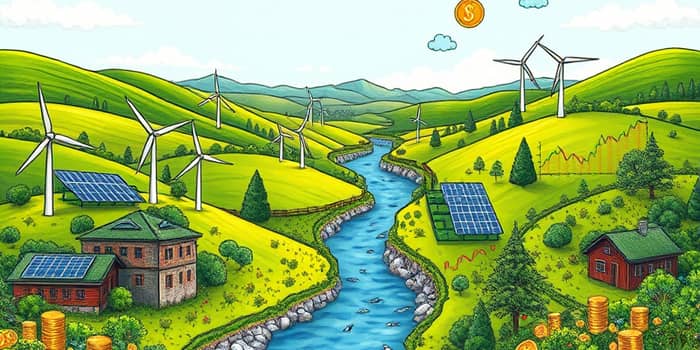
In a world facing unprecedented environmental challenges, the fusion of finance and sustainability offers a pathway to preserve our planet while generating robust returns. Green finance mobilizes capital toward projects that drive ecological progress and deliver financial performance.
At its core, green finance comprises investment vehicles and funding mechanisms dedicated to positive environmental outcomes at scale. These initiatives include renewable energy projects such as wind and solar farms, green bonds financing energy-efficient buildings, and infrastructure for electric vehicles.
Distinct from the broader umbrella of sustainable finance—which weaves Environmental, Social, and Governance considerations into all investment decisions—green finance focuses squarely on environmental impact. Transition finance further supports industries with high emissions to adopt cleaner technologies, bridging present operations with future sustainability goals.
The global green finance market reached $4.18 trillion in 2023 and is set to expand at a 21.25% compound annual growth rate (CAGR), soaring to an estimated $28.71 trillion by 2033. Meanwhile, the ESG finance segment is forecasted to grow from $8.71 trillion in 2025 to $14.98 trillion by 2030, driven by a 11.46% CAGR.
Green bonds alone accounted for $570 billion in issuance in 2021, up from $90 billion in 2016, and are projected to reach a market capitalization of $2.9 trillion by 2025. They now comprise roughly 65.4% of total ESG finance in 2024, signaling investor preference for transparent, purpose-driven debt instruments.
Regulatory frameworks, especially in Europe, create a strong legal framework driving growth. The European Green Deal aims to mobilize at least €1 trillion by 2030, while the EU taxonomy clarifies which activities qualify as environmentally sustainable.
Investor demand has surged, fueled by shareholder activism and rising consumer awareness. Technological innovations—such as blockchain-based tokenization of green assets—enhance transparency. Asia-Pacific leads the charge in developing green taxonomies, while North America remains the largest regional demand center.
The green finance toolkit encompasses a variety of instruments designed to channel capital toward sustainable projects. Each mechanism offers unique benefits and risk-return profiles.
Green finance drives tangible environmental benefits, from emission reductions to biodiversity preservation. Funding clean energy projects directly contributes to a circular economy and pollution prevention. Companies harness these instruments to manage climate risk, boosting improving risk-adjusted investment performance over the long term.
Numerous studies confirm that portfolios integrating green criteria often match or outperform traditional benchmarks, demonstrating that environmental stewardship and competitive returns can go hand in hand. Financial institutions also benefit from transparent and auditable impact reporting, which builds investor trust and safeguards market integrity.
The green finance landscape varies significantly by geography and industry:
Sectors such as renewable energy, green real estate, and sustainable transportation attract the majority of green capital, while heavy-emitting industries increasingly rely on transition finance to modernize facilities and reduce carbon footprints.
Despite its robust growth, green finance faces hurdles. Greenwashing—the risk of misleading environmental claims—undermines credibility and threatens market confidence and integrity. The lack of standardized data and varying reporting frameworks complicate impact assessment, emphasizing the need for globally harmonized benchmarks.
Market volatility and external shocks can stall issuance, as seen in recent years when geopolitical tensions and economic slowdowns tempered investor enthusiasm. Ensuring rigorous oversight and enhanced disclosure standards remains critical to sustaining momentum.
Looking ahead, industry consensus expects sustained high growth driven by regulatory mandates, technological advances, and public-private partnerships. By 2030, the green economy could deliver over $10 trillion in annual business value and support 400 million jobs worldwide, according to the World Economic Forum.
In 2025, sustainable bond issuance may surpass $1 trillion, while the global green economy could account for $7.9 trillion—equivalent to 8.6% of global listed equity market capitalization. These projections underscore the transformative power of aligning capital with ecological objectives.
Ultimately, green finance represents more than a niche investment strategy; it is a cornerstone of a resilient, equitable, and prosperous future. By harnessing market forces to combat environmental degradation, stakeholders can generate sustainable returns while safeguarding the planet for generations to come.
References





